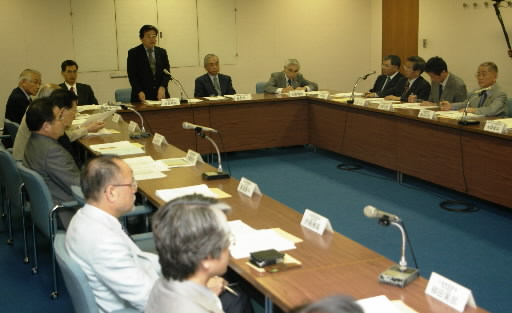Special Series: 60 Years of RERF, Part I [2]
Jun. 30, 2010
Moving beyond its past: Medical practice seeks a new path
by Hiromi Morita, Staff Writer
This feature series on the past and future of the Radiation Effects Research Foundation (RERF) originally began to appear in the Chugoku Shimbun in February 2007.
Joining forces for the future
An old semicircular-shaped building is filled with a huge refrigerator and cabinets for storing specimens that are kept under high security. Lymphocytes frozen by liquid nitrogen at a temperature of minus 180 degrees Celsius. Serums preserved at minus 80 degrees Celsius. These are some of the specimens collected from A-bomb survivors (hibakusha) with their consent.
The organic matter, which the Radiation Effects Research Foundation (RERF) in Minami Ward, Hiroshima has accumulated over the past 60 years, includes 577,006 blood and urine samples as well as 932,250 pathological tissues, including those of cancer. These samples are preserved in a state that enables them to be taken out and used for research even after the death of the person who provided the sample.
When RERF was still known by its predecessor's name, the Atomic Bomb Casualty Commission (ABCC), it was subject to harsh criticism from hibakusha, who said, "ABCC is only obtaining data from us and provides no medical treatment." Since the institute was reorganized in 1975, RERF has offered to hibakusha the results of its adult health study, which is conducted every two years. Still, it cannot be said that this effort is enough.
"If RERF purports to be conducting its studies for the benefit of hibakusha, then it should be giving more guidance to them in this regard," said Katsuaki Aoki, 58, director of Hiroshima Kyoritsu Hospital in Asaminami Ward, who deals daily with survivors coming to the hospital with the results of the studies conducted by RERF.
A female patient in her 70s who learned from testing at RERF that she suffered from kidney cancer underwent an operation. She had experienced close-range exposure to the atomic bomb at a location about one kilometer from the hypocenter. If she applied for an allowance based on the Atomic Bomb Survivors Relief Law, she would be granted the allowance. However, there was no such advice from RERF, and she almost missed the opportunity.
RERF has taken action to collaborate with hospitals and universities in the academic field, including international medical cooperation. But the institute gave an evasive answer concerning the social support of hibakusha, saying, "We are offering hibakusha advice on health issues and introducing them to appropriate medical institutions."
The fact that hibakusha are aging casts a shadow over the future of RERF. Of approximately 120,000 RERF subjects who were selected from the 1950 national census, half of them had already passed away by 1998.
How will the precious data obtained from hibakusha who were victimized by the atomic bombs be used for benefit in the future? Research institutes and administrative organs in Hiroshima with similar concerns formed a network called the "Forum for Institutes Engaged in A-bomb Survivors' Medical Care" in May 2006. The Hiroshima Red Cross and Atomic Bomb Survivors Hospital and Hiroshima University's Research Institute for Radiation Biology and Medicine (RIRBM) have also joined the network.
Shizuteru Usui, 69, the president of the Hiroshima Prefectural Medical Association and newly-inaugurated chair of the forum said, "From the standpoint of offering relief to hibakusha, the collaboration among medical institutes in Hiroshima, each of which has its own role and strengths, is vital." Dr. Usui has pinned his hopes on the forum for the survival of "medical practice" in Hiroshima.
The forum has proposed the concept of the "Hiroshima Radiation Medical Research and Treatment Center" (a tentative name), which would be jointly operated by the related institutes in the center of the city of Hiroshima. RERF, which has played the central role in researching the aftereffects of the atomic bombings, would join the center, which aims to be a base of research and clinical practice. The forum included this vision in their interim report compiled last fall.
As the member institutes of the forum are all facing financial difficulties, the future of their concept is unclear. But Kenjiro Yokoro, 80, former director of RIRBM who entered the city after the bombing and engaged in autopsies of the victims, said: "The study results will be meaningless if they are not used for clinical practice. The experience of the atomic bombings is now in danger of fading while the world faces a crisis involving nuclear weapons. If the wisdom found in the A-bomb cities is combined, this would bring more help for the hibakusha and better convey the damage wrought by the atomic bombings to the world." Dr. Yokoro is placing his hopes on his successors.
(Originally published on February 27, 2007)








